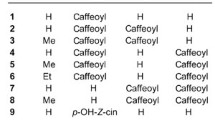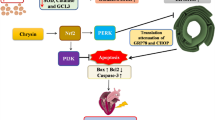Abstract
The roles of hydrogen sulfide (H2S) and endoplasmic reticulum (ER) stress in doxorubicin (DOX)-induced cardiotoxicity are still unclear. This study aimed to dissect the hypothesis that H2S could protect H9c2 cells against DOX-induced cardiotoxicity by inhibiting ER stress. Our results showed that exposure of H9c2 cells to DOX significantly inhibited the expression and activity of cystathionine-γ-lyase (CSE), a synthetase of H2S, accompanied by the decreased cell viability and the increased reactive oxygen species (ROS) accumulation. In addition, exposure of cells to H2O2 (an exogenous ROS) mimicked the inhibitory effect of DOX on the expression and activity of CSE. Pretreatment with N-acetyl-l-cysteine (NAC) (a ROS scavenger) attenuated intracellular ROS accumulation, cytotoxicity, and the inhibition of expression and activity of CSE induced by DOX. Notably, the ER stress-related proteins, including glucose-regulated protein 78 (GRP78) and C/EBP homologous protein (CHOP) were obviously upregulated in DOX-treated H9c2 cells. Pretreatment with sodium hydrosulfide (NaHS, a H2S donor) before DOX exposure markedly suppressed DOX-induced overexpressions of GRP78 and CHOP, cytotoxicity and oxidative stress. In conclusion, we have demonstrated that ROS-mediated inhibition of CSE is involved in DOX-induced cytotoxicity in H9c2 cells, and that exogenous H2S can confer protection against DOX-induced cardiotoxicity partly through inhibition of ER stress.







Similar content being viewed by others
References
Muggia FM, Green MD (1991) New anthracycline antitumor antibiotics. Crit Rev Oncol Hematol 11:43–64
Scully RE, Lipshultz SE (2007) Anthracycline cardiotoxicity in long-term survivors of childhood cancer. Cardiovasc Toxicol 7:122–128
Hrdina R, Gersl V, Klimtova I et al (2000) Anthracycline-induced cardiotoxicity. Acta Medica (Hradec Kralove) 43:75–82
Berridge MJ (2002) The endoplasmic reticulum: a multifunctional signaling organelle. Cell Calcium 32:235–249
Harding HP, Calfon M, Urano F et al (2002) Transcriptional and translational control in the Mammalian unfolded protein response. Annu Rev Cell Dev Biol 18:575–599
Lai E, Teodoro T, Volchuk A (2007) Endoplasmic reticulum stress: signaling the unfolded protein response. Physiology (Bethesda) 22:193–201
Harding HP, Zhang Y, Ron D (1999) Protein translation and folding are coupled by an endoplasmic-reticulum-resident kinase. Nature 397:271–274
Hendershot LM (2004) The ER function BiP is a master regulator of ER function. Mt Sinai J Med 71:289–297
Li J, Lee AS (2006) Stress induction of GRP78/BiP and its role in cancer. Curr Mol Med 6:45–54
Mandl J, Banhegyi G (2007) Endoplasmic reticulum stress-common pathomechanism of different diseases? Orv Hetil 148:1779–1785
Oyadomari S, Mori M (2004) Roles of CHOP/GADD153 in endoplasmic reticulum stress. Cell Death Differ 11:381–389
Zinszner H, Kuroda M, Wang X et al (1998) CHOP is implicated in programmed cell death in response to impaired function of the endoplasmic reticulum. Genes Dev 12:982–995
Liu J, Mao W, Iwai C et al (2008) Adoptive passive transfer of rabbit beta1-adrenoceptor peptide immune cardiomyopathy into the Rag2−/− mouse: participation of the ER stress. J Mol Cell Cardiol 44:304–314
Chua CC, Liu X, Gao J et al (2006) Multiple actions of pifithrin-alpha on doxorubicin-induced apoptosis in rat myoblastic H9c2 cells. Am J Physiol Heart Circ Physiol 290:H2606–H2613
Lai HC, Yeh YC, Ting CT et al (2010) Doxycycline suppresses doxorubicin-induced oxidative stress and cellular apoptosis in mouse hearts. Eur J Pharmacol 644:176–187
Reeve JL, Szegezdi E, Logue SE et al (2007) Distinct mechanisms of cardiomyocyte apoptosis induced by doxorubicin and hypoxia converge on mitochondria and are inhibited by Bcl-xL. J Cell Mol Med 11:509–520
Su YW, Liang C, Jin HF et al (2009) Hydrogen sulfide regulates cardiac function and structure in adriamycin-induced cardiomyopathy. Circ J 73:741–749
Wei H, Zhang R, Jin H et al (2010) Hydrogen sulfide attenuates hyperhomocysteinemia-induced cardiomyocytic endoplasmic reticulum stress in rats. Antioxid Redox Signal 12:1079–1091
Lowicka E, Beltowski J (2007) Hydrogen sulfide (H2S)—the third gas of interest for pharmacologists. Pharmacol Rep 59:4–24
Moore PK, Bhatia M, Moochhala S (2003) Hydrogen sulfide: from the smell of the past to the mediator of the future? Trends Pharmacol Sci 24:609–611
Wang R (2002) Two’s company, three’s a crowd: can H2S be the third endogenous gaseous transmitter? FASEB J 16:1792–1798
Yang G, Wu L, Jiang B et al (2008) H2S as a physiologic vasorelaxant: hypertension in mice with deletion of cystathionine gamma-lyase. Science 322:587–590
Bian JS, Yong QC, Pan TT et al (2006) Role of hydrogen sulfide in the cardioprotection caused by ischemic preconditioning in the rat heart and cardiac myocytes. J Pharmacol Exp Ther 316:670–678
Geng B, Chang L, Pan C et al (2004) Endogenous hydrogen sulfide regulation of myocardial injury induced by isoproterenol. Biochem Biophys Res Commun 318:756–763
Wang X, Wang Q, Guo W, Zhu YZ (2011) Hydrogen sulfide attenuates cardiac dysfunction in a rat model of heart failure: a mechanism through cardiac mitochondrial protection. Biosci Rep 31:87–98
Yang Z, Yang C, Xiao L et al (2011) Novel insights into the role of HSP90 in cytoprotection of H2S against chemical hypoxia-induced injury in H9c2 cardiac myocytes. Int J Mol Med 28:397–403
Chen SL, Yang CT, Yang ZL et al (2010) Hydrogen sulphide protects H9c2 cells against chemical hypoxia-induced injury. Clin Exp Pharmacol Physiol 37:316–321
Sodha NR, Clements RT, Feng J et al (2008) The effects of therapeutic sulfide on myocardial apoptosis in response to ischemia-reperfusion injury. Eur J Cardiothorac Surg 33:906–913
Liu Z, Song XD, Xin Y et al (2009) Protective effect of chrysoeriol against doxorubicin-induced cardiotoxicity in vitro. Chin Med J (Engl) 122:2652–2656
Tokarska-Schlattner M, Zaugg M, Zuppinger C et al (2006) New insights into doxorubicin-induced cardiotoxicity: the critical role of cellular energetics. J Mol Cell Cardiol 41:389–405
Lee AS (1992) Mammalian stress response: induction of the glucose-regulated protein family. Curr Opin Cell Biol 4:267–273
Xu C, Bailly-Maitre B, Reed JC (2005) Endoplasmic reticulum stress: cell life and death decisions. J Clin Invest 115:2656–2664
Acknowledgments
This study was supported by Science and Technology Planning Project of Guangdong Province in China (2010B080701035, 2009B080701014, and 2007B080701030).
Author information
Authors and Affiliations
Corresponding authors
Additional information
X.-Y. Wang and C.-T. Yang contributed equally to this study.
Rights and permissions
About this article
Cite this article
Wang, XY., Yang, CT., Zheng, DD. et al. Hydrogen sulfide protects H9c2 cells against doxorubicin-induced cardiotoxicity through inhibition of endoplasmic reticulum stress. Mol Cell Biochem 363, 419–426 (2012). https://doi.org/10.1007/s11010-011-1194-6
Received:
Accepted:
Published:
Issue Date:
DOI: https://doi.org/10.1007/s11010-011-1194-6




